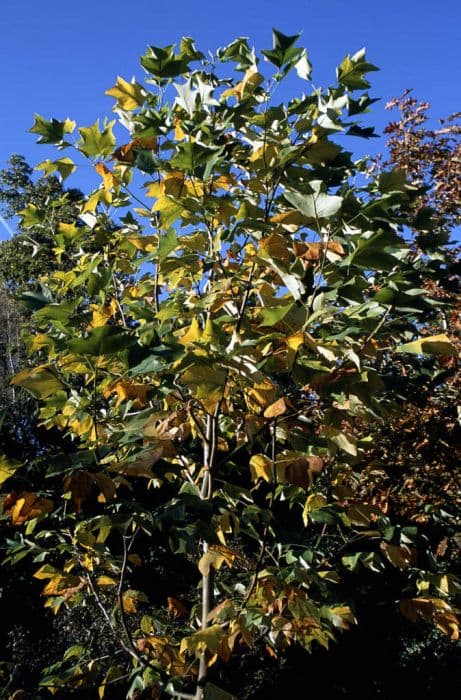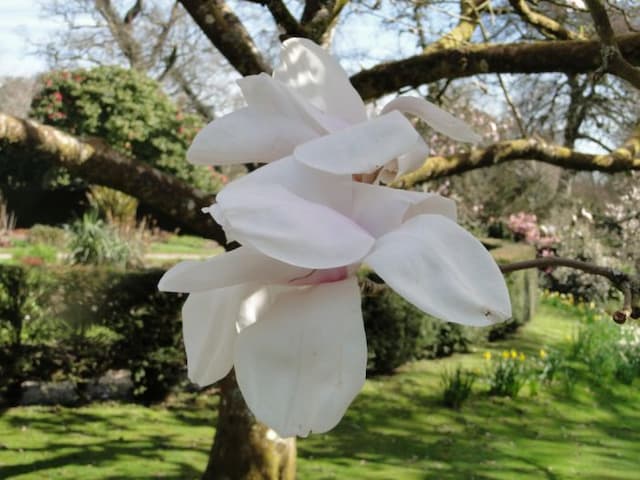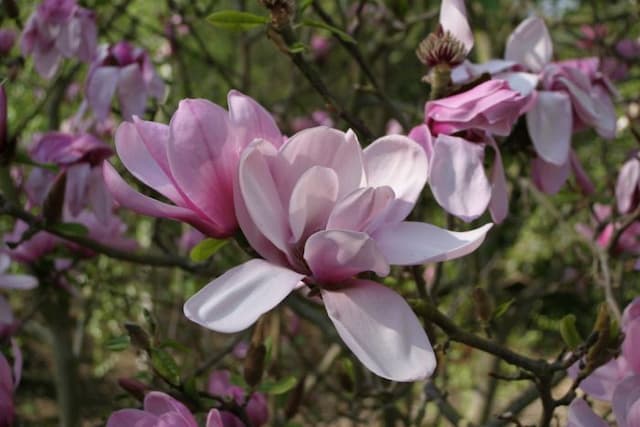Star magnolia Magnolia stellata

ABOUT
Magnolia stellata, commonly known as star magnolia, is a deciduous shrub that is well-known for its striking floral display and pleasing form. The main attraction of this plant is its beautiful, star-shaped flowers. These blooms are pure white to sometimes pale pink and consist of many slender, elongated petals that radiate from the center like the rays of a star, hence the name "star magnolia". Blossoming often occurs in early spring, before the foliage emerges, providing a breathtaking contrast against the bare branches. The leaves of the star magnolia are dark green, oval to oblong, and have a glossy texture. They provide a lush backdrop for the flowers, and in the fall, the leaves typically turn yellow or bronze, adding another layer of interest to the plant's display. Star magnolia's branches grow in a multi-stemmed, rounded habit, giving the plant an elegant and compact appearance. When not in bloom, the greyish bark and the overall structure of the plant provide a pleasing visual interest throughout the year. The buds of the star magnolia are also quite distinctive; they are fuzzy and silver-grey, offering an attractive look throughout the winter. Overall, the star magnolia is a plant of delightful beauty, cherished for its dazzling floral display and charming year-round presence.
About this plant
 Names
NamesFamily
Magnoliaceae
Synonyms
Star Magnolia, Starry Magnolia
Common names
Magnolia kobus var. stellata, Magnolia stellata var. keiskei, Magnolia stellata var. rosea.
 Toxicity
ToxicityTo humans
Star magnolia (Magnolia stellata) is generally considered non-toxic to humans. There are no significant toxins known in this plant that would commonly cause poisoning. This means that ingesting parts of the star magnolia, such as leaves or blooms, typically does not lead to any severe health consequences. However, it is always advisable to avoid eating plant parts when one is not certain of their edibility and potential effects.
To pets
Star magnolia is not toxic to pets either. It does not have any known poisonous attributes that would affect pets such as cats and dogs if they ingest parts of the plant. Therefore, the star magnolia is generally considered safe for pets, and no specific symptoms of poisoning are associated with this plant. Nonetheless, ingestion of plant material can sometimes cause mild stomach upset in animals, so monitoring pets and discouraging them from chewing on plants is always a good precaution.
 Characteristics
CharacteristicsLife cycle
Perennials
Foliage type
Deciduous
Color of leaves
Green
Flower color
White
Height
15-20 feet (4.5-6 meters)
Spread
10-15 feet (3-4.5 meters)
Plant type
Shrub
Hardiness zones
4-8
Native area
Japan
Benefits
 General Benefits
General Benefits- Ornamental value: Star magnolia features showy, fragrant white flowers that are aesthetically pleasing and enhance the visual appeal of gardens and landscapes.
- Attracts pollinators: The flowers of star magnolia provide nectar and attract bees and other pollinators, supporting local ecosystems.
- Seasonal interest: With its early spring blooms, star magnolia brings life and interest to gardens after winter dormancy.
- Shade provision: When grown to its full size, star magnolia can provide shade and a cooler microclimate during hot weather.
- Wildlife habitat: The dense foliage offers shelter and nesting sites for birds and other small wildlife.
- Low maintenance: Star magnolia is considered low maintenance, requiring minimal pruning and care once established.
- Tolerates urban conditions: It is relatively tolerant of pollution and urban conditions, making it suitable for city planting.
- Compact size: Its relatively small size makes it appropriate for smaller gardens or limited spaces.
 Medical Properties
Medical PropertiesThis plant is not used for medical purposes.
 Air-purifying Qualities
Air-purifying QualitiesThis plant is not specifically known for air purifying qualities.
 Other Uses
Other Uses- Photography and Painting Subject: Magnolia stellata, known as star magnolia, is often used by photographers and artists as a subject due to its strikingly beautiful blooms in early spring.
- Wedding Decor: The branches and blossoms of the star magnolia can be used in floral arrangements and bouquets for weddings, providing a delicate and fragrant decoration.
- Textile Dyeing: Some enthusiasts use the bark of star magnolia to create plant-based dyes for fabrics, although this is not a well-documented practice.
- Botanical Studies: Due to its distinct characteristics, star magnolia is occasionally used in educational settings for botanical studies and plant identification exercises.
- Culinary Garnish: The flowers of the star magnolia are sometimes used as an ornamental garnish for upscale culinary dishes, although they are not commonly consumed.
- Perfumery: The fragrance of the star magnolia flowers can be captured and used as inspiration in the creation of perfumes and scented products.
- Bonsai Art: The star magnolia can be cultivated as a bonsai tree, with its miniature flowers providing an aesthetic appeal for enthusiasts of this art form.
- Feng Shui: In feng shui practices, planting a star magnolia in the garden is believed to bring a soothing and peaceful energy to the space.
- Nature-Inspired Crafts: Dried star magnolia flowers and leaves can be used in crafting, such as making bookmarks, greeting cards, or decorative wreaths.
- Religious Ceremonies: In some cultures, star magnolia branches and flowers may be used in religious ceremonies as symbols of purity and nature's beauty.
Interesting Facts
 Feng Shui
Feng ShuiStar Magnolia is not used in Feng Shui practice.
 Zodiac Sign Compitability
Zodiac Sign CompitabilityStar Magnolia is not used in astrology practice.
 Plant Symbolism
Plant Symbolism- Purity: The white blossoms of the Magnolia stellata symbolize purity and innocence, often making it a cherished plant in gardens and ceremonies.
- Dignity: The magnolia flower represents a dignified and elegant bearing; the tree's stately appearance enhances this symbolism.
- Perseverance: As a plant that has existed for millions of years, magnolias exemplify persistence and longevity.
- Nobility: Magnolias are often associated with nobility, possibly due to their impressive presence and the fact that they are ancient species.
- Love of Nature: The Star Magnolia expresses a love of and connection to the natural world with its early spring blossoms.
 Water
WaterThe Star Magnolia needs regular watering to keep the soil consistently moist but not soggy. Water the plant deeply once a week, providing about 1.5 to 2 gallons of water each time, depending on the weather and soil drainage. During hot and dry spells, increase the frequency to twice a week, ensuring that the water reaches deep into the root zone. In the winter when the plant is dormant, you can reduce watering. Always check the top few inches of soil for dryness before watering to avoid overwatering.
 Light
LightThe Star Magnolia thrives in full sun to partial shade. It prefers a location where it can receive at least 4 to 6 hours of direct sunlight per day, but it also benefits from some afternoon shade in regions with very hot summers. The ideal spot for this Magnolia is one where morning sunlight is abundant, and protection from harsh afternoon light is provided to prevent leaf scorch.
 Temperature
TemperatureThe Star Magnolia is hardy and can tolerate a range of temperatures, from a winter low of around 0 degrees Fahrenheit to summer highs of about 90 degrees Fahrenheit. The ideal temperature range for this plant is between 60 and 75 degrees Fahrenheit. It can survive occasional dips below 0 degrees Fahrenheit, but prolonged exposure to extreme cold can damage the plant.
 Pruning
PruningPrune the Star Magnolia to maintain its shape and remove any dead or damaged branches. The best time to prune is soon after the flowers have faded, in late spring or early summer. This allows time for new growth and bud formation for the next year. Pruning should not be done excessively; this plant typically requires only light shaping and cleaning up of irregular growth.
 Cleaning
CleaningAs needed
 Soil
SoilStar Magnolia requires well-draining, acidic to neutral soil with a pH of 5.0 to 7.0. A mix of loamy soil, peat moss, and compost works best to retain moisture yet avoid waterlogging. Ensure the soil mix is fertile and enriched with organic matter to support its growth.
 Repotting
RepottingStar Magnolias are slow growers and do not need frequent repotting; repot them only every 3-5 years, and only if they outgrow their current space. Younger plants may require more frequent repotting than mature ones.
 Humidity & Misting
Humidity & MistingStar Magnolia prefers average to high humidity levels but is quite adaptable and can tolerate lower humidity when grown outdoors. Indoor plants may benefit from increased humidity through misting or a humidity tray.
 Suitable locations
Suitable locationsIndoor
Place Star Magnolia in bright, indirect light and ensure high humidity.
Outdoor
Plant in well-drained soil, full sun to partial shade, protect from strong winds.
Hardiness zone
4-8 USDA
 Life cycle
Life cycleStar Magnolia (Magnolia stellata) starts its life as a seed which, after dispersing from its parent plant, must undergo a period of cold stratification before germination. Once conditions are favorable, the seed germinates and a seedling emerges, which then grows into a juvenile plant through the acquisition of sunlight and nutrients. As the star magnolia matures, it develops into a young tree, characterized by its woody stem and branching habit. The tree reaches reproductive maturity after a few years, typically beginning to bloom in early spring with fragrant, star-shaped, white flowers before the leaves appear. Following pollination, often by beetles attracted to the flowers, the plant produces fruiting bodies known as follicles, holding the seeds which will then drop to the ground to continue the cycle. In favorable conditions, star magnolias can live for many decades, potentially reaching over a century in age.
 Propogation
PropogationPropogation time
Late winter to early spring
The most popular method of propagation for the Star Magnolia (Magnolia stellata) is by semi-hardwood cuttings. This process typically takes place in late summer. A cutting of about 4 to 6 inches (10 to 15 centimeters) is taken from the current year's growth, ensuring there are at least a couple of leaves on the cutting. The lower leaves are removed, and the cut end of the stem may be dipped into a rooting hormone to encourage root growth. The cutting is then placed into a pot with well-draining soil and kept moist and warm until roots develop, which can take several weeks to a few months. A plastic bag or a propagator can be used to retain humidity and ensure a suitable microclimate while the cutting is rooting.









![Magnolia [Felix Jury]](/_next/image?url=https%3A%2F%2Fplants-admin.emdemapps.com%2Fimages%2Fplants%2F%2Fimages%2F604b61a0b23b7.png&w=640&q=75)